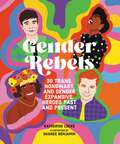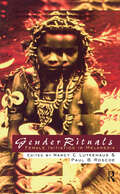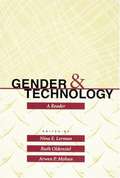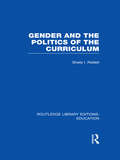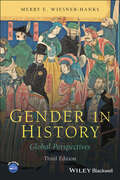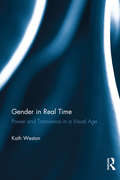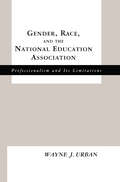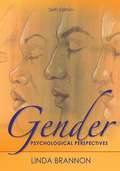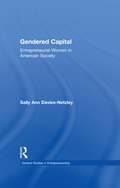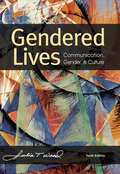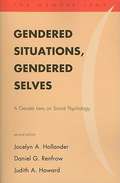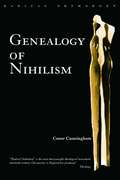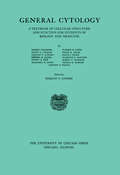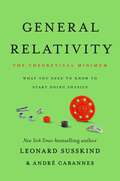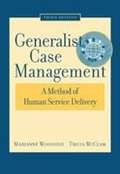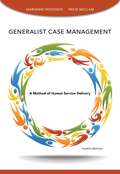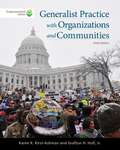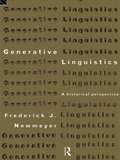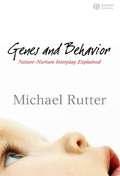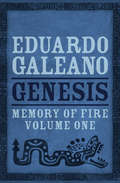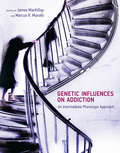- Table View
- List View
Gender Rebels: 30 Trans, Nonbinary, and Gender Expansive Heroes Past and Present
by Katherine LockeThis fully illustrated book celebrates the history of thirty trans, gender expansive, and nonbinary heroes throughout the world. Explore the history of trans and nonbinary people throughout the world in this gorgeously illustrated nonfiction book for young teens. Readers will be educated and enlightened about gender-expansive people who have made a difference in our history and who continue to help raise awareness of diversity and inclusion in current society. Introductory materials give readers an insight into pronoun usage, the history of the word "transgender," and more before providing engaging and fascinating information about thirty trans, gender expansive, and nonbinary people who have helped shape our world. From Callon of Epidaurus (the first intersex individual to receive surgery) to Elliot Page (a trans actor) to Tomoya Hosoda (the first trans politician in Japan), this book will open up dialogue and help educate young adults on the history, legacy, and future of trans, gender expansive, and nonbinary people and their rights at a time when protecting those rights is needed more than ever. The book is complete with sidebars about trans topics, a reference guide, and a glossary of terminology.
Gender Rituals: Female Initiation in Melanesia
by Nancy C. Lutkehaus Paul B. RoscoeThis volume draws together ethnographies of female initiation rites in Melanesia which require anthropologists to rethink their analysis of initiations and their perceptions of gender. The contributors argue that female initiation rites express more than cultural notions of femininity, narrow definitions of reproduction, or coming of age rituals - instead they play an important role in other life cycle rituals and in the political and economic organization of society.
Gender and Technology: A Reader
by Nina E. Lerman Ruth Oldenziel Arwen P. MohunFor most of human experience, certainly of late, the artifacts of technological civilization have become closely associated with gender, sometimes for physiological reasons but more often because of social and cultural factors, both obvious and obscure.
Gender and the Politics of the Curriculum (Routledge Library Editions: Education)
by Sheila RiddellThis book uses detailed case studies of two secondary schools to examine the relationship between curriculum choice and gender identity among fourteen-year-old pupils making their first choices about what subjects to pursue at exam level. It reveals a two way process. Pupils’ decisions on what subject to take are influenced by how they perceive themselves in gender terms, and the curriculum once chosen reinforces their sense of gender divisions. The author looks at the influences on pupils at this stage in their lives from peers, family and the labour market as well as from teachers. She argues that the belief in freedom of choice and school neutrality espoused by many teachers can become an important factor in the reproduction of gender divisions, and that unless the introduction of the national curriculum is accompanied by systematic efforts to eradicate sexism from the hidden curriculum it will fail in its aim of creating greater equality of educational opportunity among the sexes.
Gender in History: Global Perspectives (Design Principles For Teaching History Ser.)
by Merry E. Wiesner-HanksA concise yet comprehensive account of the roles and influences of gender over the millennia, featuring new and updated content throughout Gender in History: Global Perspectives, Third Edition, explores the construction and evolution of gender in many of the world’s cultures from the Paleolithic era to the COVID pandemic of the twenty-first century. Broad in geographic and topical scope, this comprehensive volume discusses the ways families, religions, social hierarchies, politics, work, education, art, sexuality, and other issues are linked to various conceptions of gender. Now organized chronologically rather than topically, this extensively revised edition presents a wealth of up-to-date information based on the scholarship of the last decade. New and expanded chapters offer insights on the connections between gender and key events and trends in world history, including domestication and the development of agriculture, the growth of cities and larger-scale political structures, the spread of world religions, changing ideas of race, class, and sexuality, colonialism and imperialism, capitalism, wars, revolutions, and more. Written by a distinguished scholar in the field of women's and gender history, this third edition of Gender in History: Examines how gender roles were shaped by family life, religious traditions, various other institutions, and how the institutions were influenced by gender Considers why gender variations developed in different cultures and in diverse social, ethnic, and racial groups within a single culture Addresses ideas in different cultures that shaped both informal societal norms and formalized laws Explores debates about the origins of patriarchy, the development of complex gender hierarchies, and contemporary movements for social change Discusses the gender implications of modern issues including the global pandemic and ongoing cultural and economic shifts Includes an accessible introduction to key theoretical and methodological issues and an instructor’s website site with visual and written original sources Gender in History: Global Perspectives, Third Edition, is essential reading for undergraduate and graduate students in courses such as those on women’s history, women in world history, and gender in world history, and a valuable supplement for general survey courses within History and Women’s and Gender Studies programs.
Gender in Real Time: Power and Transience in a Visual Age
by Kath WestonFirst published in 2003. Routledge is an imprint of Taylor & Francis, an informa company.
Gender, Race and the National Education Association: Professionalism and its Limitations (Studies in the History of Education)
by Wayne J. UrbanUrban presents the NEA in its historical context, turning a fair and clear eye on this powerful and controversial organization, and using this context to both criticize and commend. The culmination of a three decade long study, this unique volume presents an unusually thorough and much needed holistic view of the NEA.
Gender: Psychological Perspectives (6th Edition)
by Linda BrannonThis book examines the topic of gender--the behaviors and attitudes that relate to (but are not entirely congruent with) biological sex.
Gendered Capital: Entrepreneurial Women in American Enterprise (Garland Studies in Entrepreneurship)
by Sally Ann Davies-NetzleyFirst Published in 2000. Routledge is an imprint of Taylor & Francis, an informa company.
Gendered Lives: Communication, Gender, and Culture (10th Edition)
by Julia T. WoodWritten by leading gender communication scholar Julia T. Wood, GENDERED LIVES, 10th Edition introduces you to theories, research, and pragmatic information, demonstrating the multiple and often interactive ways that our views of masculinity and femininity are shaped within contemporary culture. With the most up-to-date research, balanced perspectives of masculinity and femininity, a personal introduction to the field, and a conversational first-person writing style, this engaging text encourages you to think critically about gender and our society.
Gendered Situations, Gendered Selves: A Gender Lens on Social Psychology (Second Edition)
by Judith A. Howard Jocelyn A. Hollander Daniel G. RenfrowThe book examines the basic underpinnings of everyday interaction: from how we think, to who we see ourselves and others to be, to how we interact with others. Each of these processes is based on both social psychology and gender (as differentiated from sex), as well as our racial backgrounds, ethnic heritages, socioeconomic circumstances, sexualities, and national histories. The authors present and critique each of the major theories of social psychology, social exchange, social cognition, and symbolic interaction. In doing so, the book introduces a full array of key concepts in social psychology—perception, stereotyping, attribution, self-presentation, impression management, defining social situations, exchanging resources, and balancing power and dependence in social relations. The book also discusses two fundamental aspects of human behavior—the dynamics of helping and harming. The second edition incorporates discussions of contemporary psychological and sociological research and features powerful new examples, including 9/11 and the election of Barack Obama.
Genealogy of Nihilism (Routledge Radical Orthodoxy)
by Conor CunninghamThis text re-reads Western history in the light of nihilistic logic, which pervades two millennia of Western thought. From Parmenides to Alain Badiou, via Plotinus, Avicenna, Duns Scotus, Ockham, Descartes, Spinoza, Kant, Hegel, Heidegger, Sartre, Lacan, Deleuze and Derrida, a genealogy of nothingness can be witnessed in development, with devastating consequences for the way we live.
General Chemistry
by Bruce Averill Patricia EldredgeThe overall goal of the authors with General Chemistry: Principles, Patterns, and Applications was to produce a text that introduces the students to the relevance and excitement of chemistry. Although much of first-year chemistry is taught as a service course, Bruce and Patricia feel there is no reason that the intrinsic excitement and potential of chemistry cannot be the focal point of the text and the course. So, they emphasize the positive aspects of chemistry and its relationship to students' lives, which requires bringing in applications early and often. In addition, the authors feel that many first year chemistry students have an enthusiasm for biologically and medically relevant topics, so they use an integrated approach in their text that includes explicit discussions of biological and environmental applications of chemistry. Topics relevant to materials science are also introduced to meet the more specific needs of engineering students.
General Cytology: A Textbook of Cellular Structure and Function for Students of Biology and Medicine
by Edmund V. CowdryThis volume was, at the time of publication, the largest and most comprehensive book on the subject of cytology, a branch of zoology which had grown considerably in the years before 1924. It was written by the foremost cytologists in the United States, including Robert Chambers, Edwin G. Conklin, Edmund V. Cowdry, Merle H. Jacobs, Ernest E. Just, Margaret R. Lewis, Warren H. Lewis, Frank R. Lillie, Ralph S. Lillie, Clarence E. McClung, Albert P. Mathews, Thomas H. Morgan, and Edmund B. Wilson.
General Relativity: The Theoretical Minimum (The Theoretical Minimum)
by Leonard Susskind André CabannesThe latest volume in the New York Times–bestselling physics series explains Einstein&’s masterpiece: the general theory of relativity He taught us classical mechanics, quantum mechanics, and special relativity. Now, physicist Leonard Susskind, assisted by a new collaborator, André Cabannes, returns to tackle Einstein&’s general theory of relativity. Starting from the equivalence principle and covering the necessary mathematics of Riemannian spaces and tensor calculus, Susskind and Cabannes explain the link between gravity and geometry. They delve into black holes, establish Einstein field equations, and solve them to describe gravity waves. The authors provide vivid explanations that, to borrow a phrase from Einstein himself, are as simple as possible (but no simpler). An approachable yet rigorous introduction to one of the most important topics in physics, General Relativity is a must-read for anyone who wants a deeper knowledge of the universe&’s real structure.
Generalist Case Management: A Method of Human Service Delivery
by Tricia Mcclam Marianne R. WoodsideGoing beyond traditional definitions of case management, the authors (of the U. of Tennessee) suggest a broader perspective that sees a greater emphasis on its role in service delivery in the human services. In this introduction to case management, they describe the case management process from intake interview to termination; examine professional issues and skills, discuss the history of case management, and describe the models used. They also cover ethical and legal issues and conclude with a chapter on managing a career as a case manager. Annotation ©2005 Book News, Inc., Portland, OR (booknews.com)
Generalist Case Management: A Method of Human Service Delivery (Fourth Edition)
by Marianne Woodside Tricia McclamBecome an effective case manager with GENERALIST CASE MANAGEMENT: A METHOD OF HUMAN SERVICE DELIVERY, 4th Edition. Realistic and relevant, this counseling book provides you with the fundamental skills and information you need to coordinate and provide services to a variety of populations. Case studies, interviews with human service case managers nationwide, and opportunities to apply what you learn to real-life issues are just a few of the tools that will help you become an effective advocate for your client.
Generalist Practice with Organizations and Communities, Sixth Edition
by Karen K. Kirst-Ashman Grafton H. HullThis book is a guide to generalist social work practice with organizations and communities. The sixth edition is thoroughly updated to reflect the Council on Social Work Education's (CSWE) latest ethical standards as well as contemporary issues in social work literature.
Generation Next
by Oli WhiteThings haven't been easy for Jack recently - life as a teenager has its ups and downs. But when he meets a new group of friends, who are every bit as geek as they are chic, his luck seems to be changing. Each of the group is talented and when they pool together to create Generation Next, an incredible new kind of social media platform, it's clear that they're on to something special. What if your Instagram account grew by hundreds of thousands of followers overnight, and big companies were fighting each other to offer you photoshoots? When GenNext suddenly goes viral, Jack and his friends are thrust into a crazy world of fame which is as terrifying as it is awesome. Because someone out there is determined to trip Jack up at every step. If he doesn't stop them, soon everyone he cares about - his friends, his family, and the girl he's falling for - will be in danger...
Generative Linguistics: An Historical Perspective (History of Linguistic Thought)
by Frederick J. NewmeyerFirst published in 1997. Routledge is an imprint of Taylor & Francis, an informa company.
Genes and Behavior: Nature-Nurture Interplay Explained
by Michael RutterIn this major new book, eminent scientist Professor Sir Michael Rutter gets behind the hype of the behavioral genetics debate to provide a balanced and authoritative overview of the genetic revolution and its implications for understanding human behavior. Written by one of the world's leading figures in child psychology and psychiatry, Professor Sir Michael Rutter Provides non-technical explanation of genetics to diffuse the sensational debates surrounding the topic Sets out in layman's terms what genes do, how much is nature and how much is nurture Argues that nature and nurture are not truly separate and gives examples of how the two interact Looks at the implications of genetic findings for policy and practice The book will inform public debate about the implications of the Human Genome Project and, more broadly, the field of genetic science.
Genesis: Genesis, Faces And Masks, And Century Of The Wind (Memory of Fire #1)
by Eduardo Galeano&“An epic work of literary creation . . . There could be no greater vindication of the wonders of the lands and people of Latin America than Memory of Fire.&” —The Washington PostEduardo Galeano&’s monumental three-volume retelling of the history of the New World begins with Genesis, a vast chain of legends sweeping from the birth of creation to the era of savage colonialism. Through lyrical prose and deep understanding, Galeano (author of the celebrated Open Veins of Latin America) recounts creation myths, pre-Columbian societies, and the brutality of conquest, from the Andes to the Great Plains.Galeano&’s project to restore to history &“breath, liberty, and the word&” unfolds as a unique, powerful work of literature. This daring masterpiece sets the past free, weaving a new kind of history from mythology, silenced voices, and the clash of worlds. Genesis is the first book of the Memory of Fire trilogy, which continues with Faces and Masks and Century of the Wind.
Genetic Influences on Addiction: An Intermediate Phenotype Approach (The\mit Press Ser.)
by James MacKillopA comprehensive review of research examining intermediary mechanisms to understand the link between genetic variation and addiction liability.Although there is scientific consensus that genetic factors play a substantial role in an individual's vulnerability to drug or alcohol addiction, specific genetic variables linked to risk or resilience remain elusive. Understanding how genetic factors contribute to addiction may require focusing on intermediary mechanisms, or intermediate phenotypes, that connect genetic variation and risk for addiction. This book offers a comprehensive review of this mechanistic-centered approach and the most promising intermediate phenotypes identified in empirical research.The contributors first consider the most established findings in the field, including variability in drug metabolism, brain electrophysiological profiles, and subjective reactions to direct drug effects; they go on to review highly promising areas such as expectancies, attentional processing, and behavioral economic variables; and finally, they investigate more exploratory approaches, including the differential susceptibility hypothesis and epigenetic modifications. Taken together, the chapters offer a macro-level testing of the hypothesis that these alternative, mechanistic phenotypes can advance the understanding of genetic influences on addiction. The book will be of interest to researchers and practitioners in a range of disciplines, including behavioral genetics, psychology, pharmacology, neuroscience, and sociology.ContributorsJohn Acker, Steven R.H. Beach, Gene H. Brody, Angela D. Bryan, Megan J. Chenoweth, Danielle M. Dick, Eske D. Derks, Mary-Anne Enoch, Meg Gerrard, Frederick X. Gibbons, Thomas E. Gladwin, Mark S. Goldman, Marcus Heilig, Kent E. Hutchison, Hollis C. Karoly, Steven M. Kogan, Man Kit Lei, Susan Luczak, James MacKillop, Renee E. Magnan, Leah M. Mayo, Marcus R. Munafò, Daria Orlowska, Abraham A. Palmer, Danielle Pandika, Clarissa C. Parker, Robert A. Philibert, Lara A. Ray, Richard R. Reich, Ronald L. Simons, Courtney J. Stevens, Rachel E. Thayer, Rachel F. Tyndale, Tamara L. Wall, Reinout W. Wiers, Michael Windle, Harriet de Wit
Gennaro's Easy Italian
by Gennaro ContaldoGENNARO'S EASY ITALIAN includes over 100 straightforward recipes that can be cooked by anyone in less than 45 minutes. Including everyday staples, creative uses of leftovers and fantastic tasty dishes and treats for children, the recipes are also perfect for easy entertaining. The book includes classics such as Tomato Sauce and Minestrone, to more unusual dishes such as Strawberry Risotto, and not forgetting the delights of Lemon and Almond Cake, Biscotti and Amaretto Ice Cream.
Gennaro's Italian Home Cooking
by Gennaro ContaldoWhen an Italian cooks dinner, it's always a meal to savour and enjoy with as many people as can be found to share it with. InÊGENNARO'S HOME COOKING, Gennaro shares his favourite family recipes - the ones that will feed a crowd of hungry guests, from his 90-year-old father to his three-year-old twin girls. Older generations give advice, all hands are on deck to help, and the whole family sit themselves down at the large dining table to join in the feast together. The table is like the altar - to eat, drink, discuss, argue and confess - but most of all to enjoy the wonderful food! All the recipes cater for large numbers of people, but have tips on how to adapt them for smaller groups, there are hints on how to prepare things in advance and advice on which dishes go with what, so it is full of creative menu ideas. WithÊGENNARO'S HOME COOKINGÊyou have everything you need to make your own kitchen a little slice of Italy.
